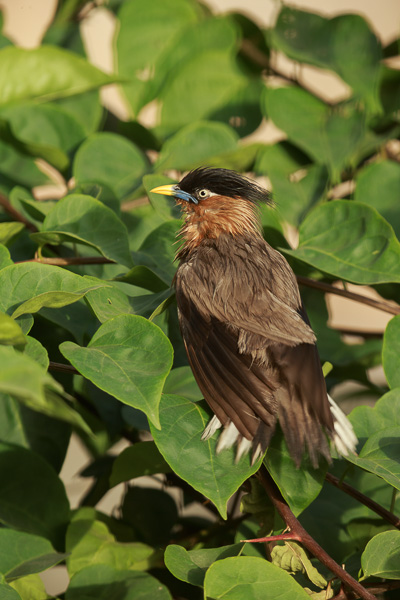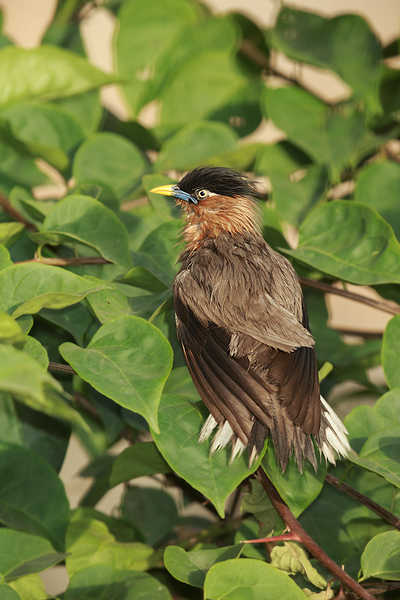13
Jun
Bird Photography Tips: Use That Flash!
- By Gaurav Mittal
- No Comments
The verdict is in. The weatherman says that the monsoon will hit Delhi by the end of June. Soon we will all be able to get respite from this suffocating heat. The birds too have been busy trying to beat the heat by crowding the big birdbath that I have in my back yard, it’s like a swimming pool filled with rowdy kids splashing away!
Recently I saw a Brahminy Myna perched on a bougainvillea in my back yard preening itself after a long session in the birdbath. What really caught my eye was the textures of the hair which looked a bit painterly to me caused by the water, missing was the shine and gloss which would have made the bird look a bit surreal. I was on the wrong side of the light and it was not possible for me to move. The image above was made with a Canon ID X and a 600mm lens at F/9.0 and 1/200sec, the bird in this image lacks detail and quite frankly I find the dark shadows within the bush quite distracting, moreover the bird is also lacking the glow and shine I was looking for. Keep reading and you will know where I’m going with this.
As excited as I’m about the approaching monsoon, I’m much excited about knowing how to use fill flash in situations where the natural light is either missing or on your wrong side, it is also good to be creative with flash. To work with fill flash on subjects such as birds at a distance you will need some basic knowledge on how to operate a flash and some special equipment. You need an off camera flash bracket and a flash cord, the function of these are to give you the flexibility to mount your flash away from the camera while still being connected to it. You also need a “Better Beamer” that attaches in front of your flash and extends its range.
This image was made with exactly the same exposure settings as above. I added a Canon 580 EX II flash set to manual mode and power reduced to -3 stops with a better beamer attached and set to a 50mm range. Comparing this image to the first one will revel some differences, this image is more dynamic and it has better contrast. The fill flash has added light in the dark openings within the bougainvillea which were previously dark and distracting, moreover it has given the bird that sheen and glow it was previously missing.
Here are some bird photography tips to remember about flash use:
- Manual mode works best if shooting a subject at a fixed distance. You control the flash output for a given distance, same result every time and you can change the output when needed.
- The shutter consists of two curtains that move across the sensor frame. For the entire frame to be exposed to the flash, your shutter speed needs to be slow enough that the first curtain has completely cleared the sensor area before the second curtain starts moving. At that point the flash is fired.
- Remember to turn on High Speed Sync; it is the third button from the top on the 580 EX II below the LCD panel. HSS allows you to work with higher shutter speeds then the maximum sync speed, this lets you expose for ambient light and use the flash separately to light the main subject. This is where you can do some creative shooting with lighting effects.
- Maximum sync speed is the fastest shutter speed at which the entire sensor frame is still open for flash to expose the frame evenly. For most camera’s it is either 1/200 or 1/250sec.
- Wait for the right moment to shoot and only take one or two shots at a time, flash needs time to recycle back to full power, it will reduce the chance of an underexposed image of a subject that was posing beautifully but you just did not have the flash at full power.
- Always use a battery pack, the recycling time is faster and it will give you more flash time. I have gone a full three days before needing a recharge.
- Try to keep from over flashing your subject; your goal should be to make images that give a natural and not an electric look.
Flash photography requires not just the knowledge of your equipment, but also patience and practice. It is a play of light that when applied correctly will give some very pleasing results. As far as the ethics of using flash in bird or for that matter any wildlife photography, it is not an issue as long as you are not intruding the space of your subject or flashing away indiscriminately. Respect the wild and move away if you sense fear or restlessness in your subject. As I have mentioned above, I follow practices that I tell others, be prepared for the right moment and shoot only when necessary.






Submit a Comment